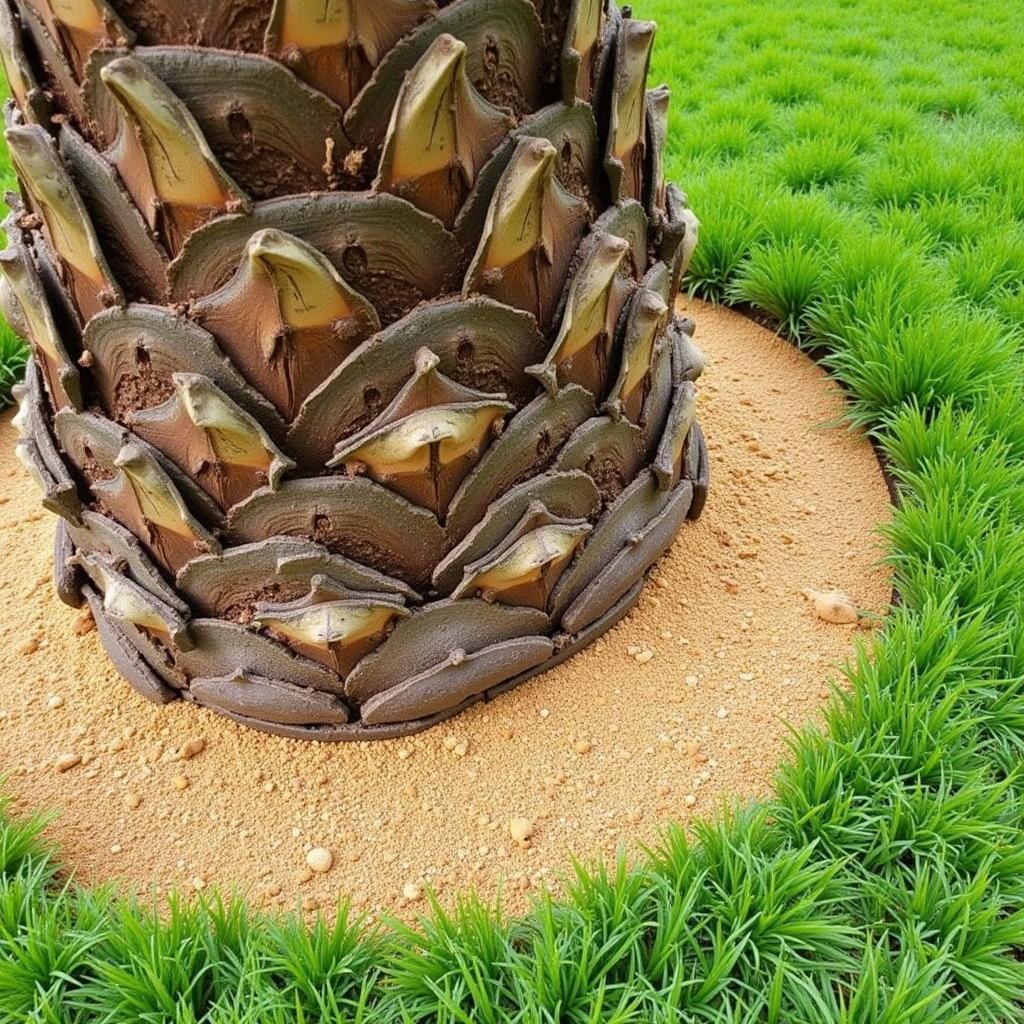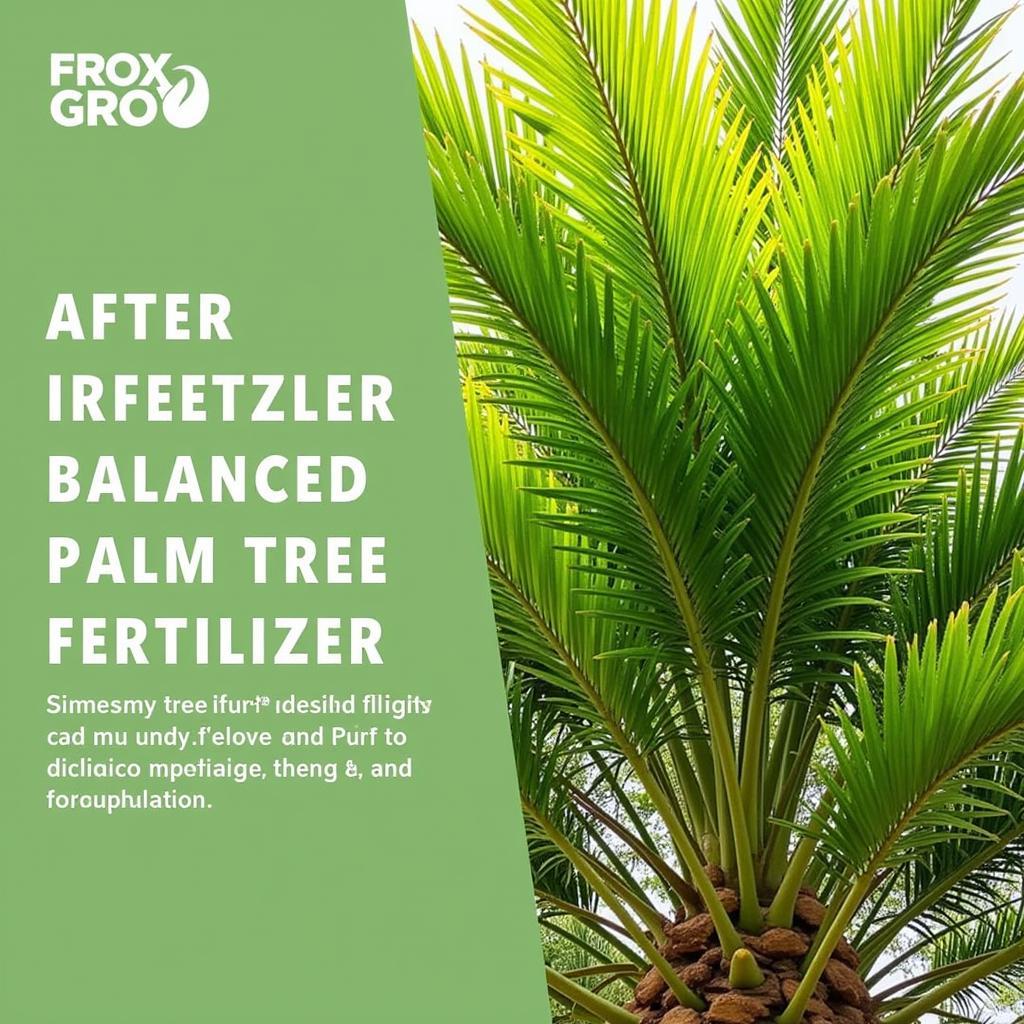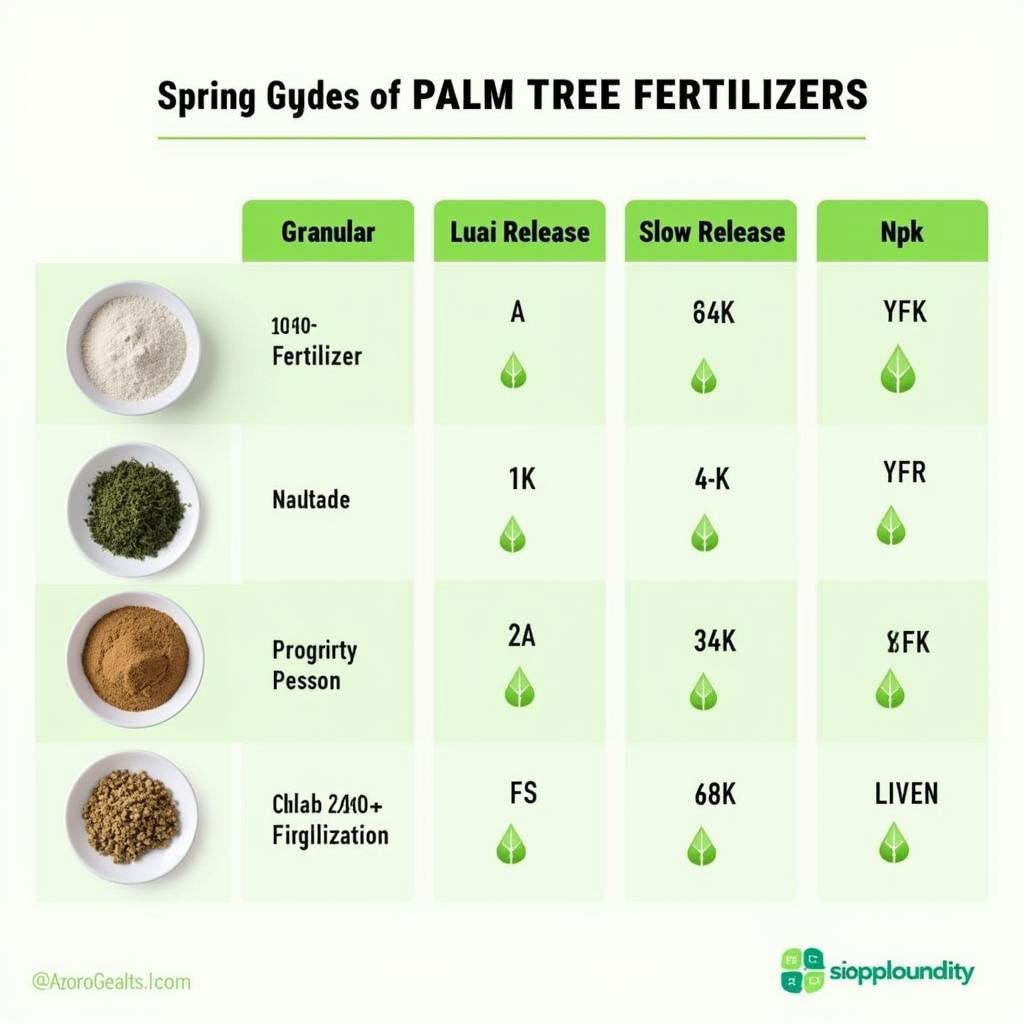Palm trees, with their majestic fronds and tropical allure, bring a touch of paradise to any landscape. But like all living things, they need proper nourishment to thrive. Understanding the nuances of Palm Tree Food Fertilizer is crucial for maintaining their health and vibrancy. This guide will delve into the essential aspects of fertilizing palm trees, ensuring you have the knowledge to keep your palms flourishing.
Understanding the Nutritional Needs of Palm Trees
Palm trees have specific nutritional requirements that differ from other trees. They are particularly heavy feeders of nitrogen, potassium, and magnesium, often lacking these crucial nutrients in typical garden soil. A deficiency in any of these nutrients can manifest in various ways, such as yellowing fronds, stunted growth, and reduced resistance to diseases and pests. Choosing the right palm food fertilizer is essential to address these needs and ensure your palm’s longevity. palm food fertilizer is specifically formulated to meet these unique requirements.
Providing a balanced diet of essential nutrients is key to maintaining the health and beauty of your palm trees. This includes not only the primary macronutrients but also micronutrients like manganese, iron, and zinc. These micronutrients play vital roles in various physiological processes, contributing to the overall vigor of the palm.
Choosing the Right Palm Tree Food Fertilizer
Selecting the correct fertilizer is paramount to your palm’s health. Look for a palm food fertilizer with a balanced NPK ratio, specifically formulated for palm trees. A slow-release granular fertilizer is often preferred as it provides a consistent supply of nutrients over time, minimizing the risk of over-fertilizing. Liquid fertilizers can be used for quick nutrient boosts but require more frequent applications.
The composition of your soil also plays a role in fertilizer selection. Conducting a soil test can provide valuable insights into existing nutrient levels, allowing you to tailor your fertilizer choice accordingly. This personalized approach ensures that your palm receives the precise nutrients it needs, promoting optimal growth and preventing nutrient deficiencies.
 Applying Palm Tree Fertilizer
Applying Palm Tree Fertilizer
When and How to Fertilize
The timing and method of fertilizer application are crucial for maximizing nutrient uptake. Generally, palm trees benefit most from fertilization during their active growing season, which typically falls between spring and summer. Applying fertilizer during the dormant winter months can be detrimental, leading to nutrient runoff and potential root damage.
When applying granular fertilizer, distribute it evenly around the base of the tree, extending outwards to the drip line, which is the area directly beneath the outermost leaves. Avoid piling fertilizer against the trunk as this can cause burning. Water the area thoroughly after application to help dissolve the granules and facilitate nutrient absorption.
Why is Specialized Palm Tree Food Important?
Using a specialized palm food fertilizer is vital for several reasons. Unlike generic fertilizers, palm food fertilizers address the specific nutritional needs of palm trees, providing a balanced blend of essential macronutrients and micronutrients. This targeted approach ensures that your palms receive the right nutrients in the right proportions, promoting healthy growth and vibrant foliage.
Generic fertilizers often lack the specific micronutrients that palm trees require, potentially leading to deficiencies. These deficiencies can manifest in various symptoms, such as yellowing leaves, stunted growth, and reduced resistance to diseases and pests.
 Thriving Palm Tree Post-Fertilization
Thriving Palm Tree Post-Fertilization
Common Problems and Solutions
Even with proper fertilization, palm trees can sometimes encounter nutritional issues. Yellowing fronds, for instance, can indicate a magnesium deficiency, while stunted growth can be a sign of nitrogen or potassium deficiency. Regularly monitoring your palm’s health and addressing any emerging issues promptly is crucial for maintaining its long-term well-being. palm food fertilizer can help prevent these issues.
- Yellowing older fronds: This could indicate a magnesium deficiency. Consider supplementing with magnesium sulfate.
- Stunted growth: This might signify a lack of nitrogen or potassium. Ensure your fertilizer has a balanced NPK ratio.
- Tip burn: This could be due to excessive fertilization or salt buildup in the soil. Leach the soil with fresh water to remove excess salts.
Expert Insights on Palm Tree Fertilization
Dr. Amelia Green, a renowned horticulturalist specializing in tropical plants, emphasizes the importance of tailored fertilization: “Palm trees are not one-size-fits-all when it comes to nutrition. Understanding their specific needs and providing a balanced fertilizer is crucial for their long-term health and vibrancy.”
Professor David Miller, a leading expert in soil science, adds, “Soil testing is an invaluable tool for palm tree care. It provides a clear picture of your soil’s nutrient composition, allowing you to choose the right fertilizer and avoid both deficiencies and excesses.”
 Different Types of Palm Tree Fertilizers
Different Types of Palm Tree Fertilizers
Conclusion
Nourishing your palm trees with the right palm tree food fertilizer is an investment in their long-term health and beauty. By understanding their specific nutritional needs and following best practices for fertilization, you can ensure that your palms thrive for years to come. Investing in quality palm food fertilizer is key to maintaining their vibrant green foliage and overall health.
FAQs
- How often should I fertilize my palm tree? Generally, fertilize 2-3 times during the growing season (spring and summer).
- What is the best NPK ratio for palm trees? A balanced ratio like 8-2-12 or 12-4-12 is generally recommended.
- Can I use generic fertilizer on my palm tree? It’s best to use a specialized palm food fertilizer to address their specific needs.
- What are the signs of over-fertilization? Tip burn, wilting, and leaf discoloration can indicate over-fertilization.
- How can I tell if my palm tree has a nutrient deficiency? Yellowing fronds, stunted growth, and spotting can be signs of deficiencies.
- Should I fertilize newly planted palm trees? Wait a few months after planting before fertilizing to allow the roots to establish.
- Is it necessary to conduct a soil test? A soil test can provide valuable insights into your soil’s nutrient levels, helping you tailor your fertilizer application.
Need help with your palm trees? Contact us at Phone Number: 02437655121, Email: minacones@gmail.com or visit us at 3PGH+8R9, ĐT70A, thôn Trung, Bắc Từ Liêm, Hà Nội, Việt Nam. We have a 24/7 customer service team.